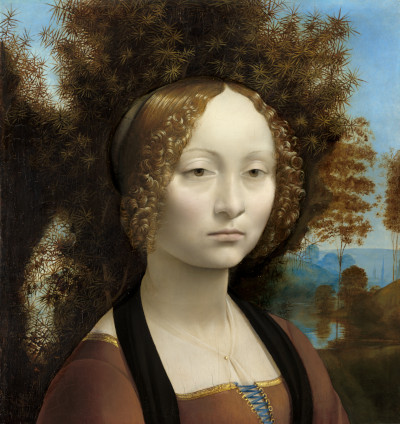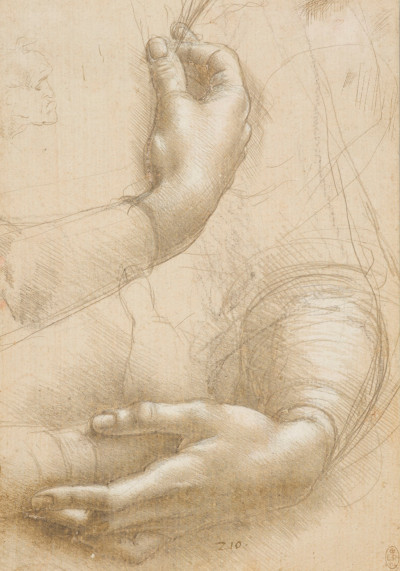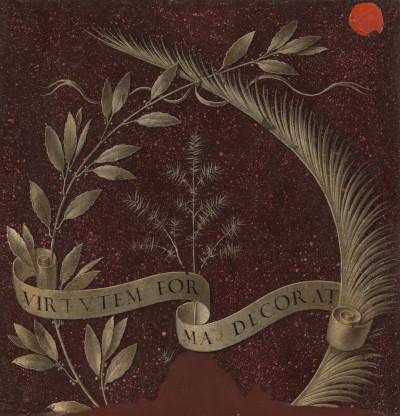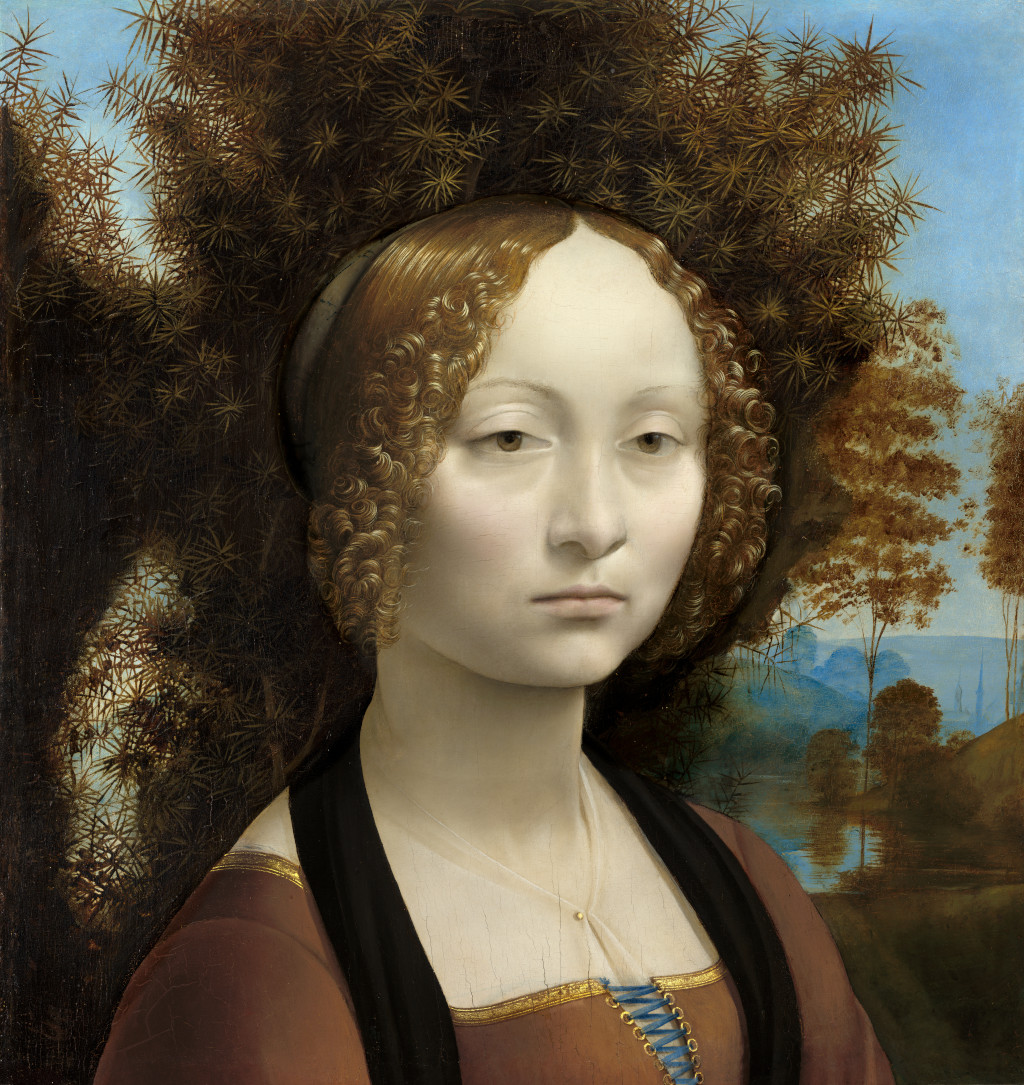This portrait of Ginevra de' Benci, from circa 1478-1480, was Leonardo da Vinci's first secular painting. It marked a new direction in his career, and a movement away from the influences of the Verrocchio workshop.
Leonardo da Vinci was tasked with producing a portrait which celebrated the beauty of this stunning Florentine teen, possibly in order to celebrate her upcoming marriage. Typically his content had all been inspired by religious texts, including a series of Madonnas which were very much in keeping with 15th century Italian art. The artist's delight with the finished portrait would encourage him to return to this format in the following decade where other notable figures from Italian society would appear within his oeuvre.
"Beauty Adorns Virtue"
Written on reverse
Within the portrait itself, Ginevra is positioned unusually close to the viewer, which strengthens her significance within the overall composition. Very little room is left for anything else, with trees arranged around her head, and a small glimpse of sky showing through down the right hand side. Her complexion is particularly light in tone, synonymous with beauty during that period.
Her expression is serious, with her gaze drifting off to our right hand side. Her clothes are smart, but relatively simple considering her wealthy background. The removal of the lower part of the painting gives us a slightly difference balance to the composition as would have been originally intended by the artist.
Some have argued that the commissioner himself, Bernardo Bembo, may have spent time elsewhere in Europe where he would have come across alternative styles of portraiture. He might then have instructed Da Vinci over how to plan this piece, encouraging the artist to break away from the traditional approaches found in Florence up to that point. Some have drawn comparisons with styles found with North European painters such as Jan van Eyck and Petrus Christus, for example.
This portrait of Ginevra de' Benci remains the only Leonardo da Vinci painting currently on public display anywhere in the US, making it a critically important addition to permanent collection of the National Gallery of Art in Washington DC, USA. It has resided there since the 1960s and is one of the highlights to be found in this prestigious location. The very nature of Renaissance art has made it difficult to relocate much of it abroad, as well as the inclination for owners not to part with these historically significant pieces.
Whilst it would have been a surprise to see Da Vinci move away from the religious themes which had dominated his earlier paintings, this change is likely to have been influenced by some of his personal relationships, and eventually he was persuaded to produce portraits of local Florentine aristocrats. This brought depth to his oeuvre and he clearly enjoyed this new approach, choosing to produce a number of similar portraits in the decade that followed.
Table of Contents
- Background
- Who was Ginevra de' Benci?
- Commission
- Preparation
- Meaning
- Analysis
- Technique
- Size and Medium
- Reverse Painting
- Attribution
- Location
- Value
- Timeline
- Large Image of the Portrait of Ginevra de' Benci
- References
Background
Ginevra de' Benci was a famous local beauty in Florence at the time of this commission, and the artist was well acquianted with the Benci family. Many had courted her, with poets even featuring her within various passages, always speaking of her beauty in glowing terms. In normal circumstances Da Vinci may well not have been persuaded to part from his existing course of focusing on religious themes for this approach had served him well in the early part of his career, but he believed the aesthetic beauty of this teen would suit his first secular portrait.
Many of the elements found within the completed portrait would continue into later work, such as the serious expression by the sitter, and also the dominant position that she holds within the overall composition. More generally, young women were rarely featured in portraits at this time, other than as celebrations of engagements or marriages, but it is possible that this piece was actually just for the purposes of friendship. The inclusion of identity symbols on the reverse of the painting which appear to refer to both the sitter and also the commissioner provide an extra dimension to the main portrait.
Who was Ginevra de' Benci?
Ginevra de' Benci lived from 1457 to 1521, and would have been in her late teens at around the time of this portrait. She came from a wealthy family who made their money as merchants and quickly attracted the attention of a number of Florentine poets who would feature her in their texts. She was already married by the time of this painting, but later became embroiled in a love affair which forced her to live a low-key life from then on.
Some have suggested that this portrait was actually a gift to celebrate her engagement or marriage, from Ginevra's close friend. The dates roughly correlate to this, but it is hard to be overly confident as the portrait is loosely placed between the years of circa 1478-1480. The artist understood the requirement of this commission, bringing the model forward and enlarging her appearance to provide a greater impact and underline her own natural beauty.
We also know that Leonardo was close friends with Ginevra's brother, Giovanni, which provided another strand of evidence when historians were attempting to precisely attribute the piece. In fact, Giovanni's son, Amerigo, would temporarily possess other Da Vinci artworks at a later date and so the artist's connection to the Benci family would continue for many years after this portrait was finished in the 1470s.
Commission
Bernardo Bembo is believed by most to have been responsible for commissioning Leonardo da Vinci to paint this portrait. He had a strong relationship with the sitter, Ginevra de' Benci, though their friendship was believed to have been entirely platonic. Bembo himself was a diplomat and humanist from Venice, which involved regular travel and he would have spent time in Florence at several points in his professional life.
Ginevra shed tears as you go, Bembo.
Alessandro Bracessi
May she desire long delays and
Beseech the Gods above that
Every difficulty may hinder your journey.
And may she wish that the kindly stars
With adverse winds and heavy storms
Prevent your departure
A particular spell in Florence coincided perfectly with the approximate dates given to this painting, of around 1478-1480, adding to a wealth of evidence that it was he who lie behind the commission of this piece. Bembo was born on the 19th of October, 1433, and so would have been around his mid-forties by the time that this piece was produced. He would study philosophy at the University of Padua and would begin his work as a diplomat around a decade later. He was a follower of poetry and the visual arts, and may have been the subject of a portrait by Hans Memling at around the same time that Da Vinci was working on this more famous piece.
Although Bembo was based predominantly in Venice, the artwork would never reach that destination and it is unclear as to why. It may have been that he simply did not pay for the item, or more likely he would have gifted it to his friend Ginevra before he returned to Venice. The personal message inscribed on the reverse of the painting also makes this the more likely explanation.
Preparation
Leonardo da Vinci would normally prepare for his paintings by completing whole series of sketches first. These would be produced in a variety of mediums, including charcoal, metalpoint, white heightening and other choices. A sketch remains of two female hands together on the same sheet of paper, and many have suggested that this sketch of female hands was a study for his portrait of Ginevra de' Benci as it remained before being cropped in later years.
Most experts think it likely that her hands were originally included in the painting, but this particular sketch probably came later and was instead for an alternative portrait. Many of these drawings would be passed around art schools as a method of study, and their fragile nature meant most would not last long. The artist would actually practice his handling of the human body throughout his lifetime, and so although we don't have specific study drawings for this portrait, many others would have helped him to prepare for this piece.
Those viewing the piece up close will also notice the detail on trees across the background, as well as a number of buildings in the far distance to the right hand side. These likely would have been added at the end, and perhaps laid out with simple sketches before being added to the main painted composition. Da Vinci would have spent much more time preparing the key features of the model's face, as these were the main focal point of the piece.
Meaning
The portrait was likely a gift from Bernardo Bembo to his friend, Ginevra de' Benci. Her natural beauty is reflected in the precise brushwork by Da Vinci, and a message from the commissioner on the reverse of the painting. Ginevra and her friend would spend time enjoying poetry together and built a strong relationship, though it is believed to have been entirely platonic in its nature.
Bembo himself was a great lover of the arts, both visual but also the various disciplines of literature, and so would seek out like-minded people when travelling around Italy as part of his role as a diplomat. In this example a Juniper bush was added to the reverse of the artwork, and the Italian name for this plant is similar to Ginevra. There is also the commissioner's motto alongside, connecting the two individuals together in this memorable gift. It is perhaps unusual for a platonic relationship to be as close as this, but no evidence has been uncovered that questions this conclusion.
If those beliefs are correct, then Da Vinci would have been instructed to create a personal atmosphere to this portrait, and to portray Ginevra is as beautiful and complementary an image as possible. Besides these background elements to the commission, the techniques used in this portrait are generally typical of the artist throughout this period of his career.
Analysis
Technique
Da Vinci was respected for the precision and life-like nature of his portraits, developing methods that allowed glazes to be further refined and blended more smoothly together. He took much from previous artists across Italy, but added these subtle additions which helped to push the Renaissance onwards once more. His most memorable achievements for many were actually his inventive designs and raw portrait sketches with charcoal or chalk, but a small selection of paintings in oil and tempera were also highly significant. The artist was well schooled in the traditional techniques of the Early Renaissance but immediately set about evolving these ideas with touches of his own.
Style
This portrait came about during Da Vinci's first Florentine period, which lasted from around 1472–1482. The artist was very young at this stage and still learning his trade as a painter. The portrait itself would mark a change in his development, with further changes continuing over the next few decades as he moved further and further away from the original teachings that he enjoyed as a young student. He was therefore starting to come out of his shell a little more, and one of the trademarks of this would be a precision and lifelike nature to his work which no other Renaissance artist could manage at that time. He was able to blend glazes with great subtlety which could trick the eye into thinking that the image in front of them was real. We would see this again in later female portraits, such as Lady with an Ermine.
Composition
One must imagine the original composition, prior to the painting being cropped across the bottom. The shoulders would have continued towards the lower edges of the work, creating a triangular shape leading to the tip of the head. This was a very common approach within Italian art at that time. The bushy trees in the background are carefully placed to surround the young lady's head, and are thick enough to block out most of the blue sky around her outline. Over her left shoulder we then find a charming landscape scene, with rolling hills and a tranquil river leading off into the distance.
This sets the scene of the model's local environment within Florence and adds additional aesthetic value to the painting. The view off to the right also brings a depth to the piece, rather than placing the model in front of a flat wall as it was often scene at this time. The angle of Ginevra is also carefully thought out, with her posture slightly leaning away from the viewer, and with her gaze not quite directly at us. This creates a slight barrier between the portrait and the viewer, and was something the artist continued with other later portraits.
Influences
This portrait of Ginevra de' Benci bears certain hallmarks of North European art which may have come about as a result of the influence of the commissioner himself, Bernardo Bembo. He had spent time abroad whilst working as a diplomat and would have discovered alternative artistic approaches whilst there. Some have argued that he would have requested some of these ideas within this portrait, which might explain why Da Vinci worked in the ways that he did. The use of oils themselves had come from the likes of Van Eyck, and so this direction of influence was nothing new, with Italians previously preferring tempera and fresco art instead.
Size and Medium
The portrait was produced using a combination of oil and tempera on poplar. The piece is today sized at 38.8cm by 36.7cm. The artwork would originally have been longer, in a traditional portrait format, but parts of the bottom half were removed some years later due to damage. Experts have suggested that around 12 to 15cms of length was removed at some point prior to 1780, with some smaller parts of the right hand side also removed.
It has proven impossible to pinpoint just exactly when these changes were made as little documentation about this piece prior to 1780 exists. Thankfully, the decision to crop out damaged parts of the painting may have helped to preserve what remains up to the present day and modern generations have developed better techniques for protecting old paintings such as this. A surviving drawing from Da Vinci's career suggests how the removed parts would have looked, with the view extending down to the young lady's hands.
Reverse Painting
Many are completely unaware of the artwork found on the reverse of this famous portrait. Often artists would re-use their resources by working on both sides of a wooden panel or canvas, but in this case, the two artworks are actually closely connected. The elements of this unnamed piece feature a laurel branch, a palm branch as well as a written text painted onto a curled scroll. All of this relates to Bernardo Bembo, who is believed by most art historians to have commissioned the portrait of Ginevra de' Benci.
The banderole contains the words, "...Virtvtem Forma Decorat", which translates loosely as "Beauty Adorns Virtue." It is clearly a reference to the painting on the other side of this thick slice of poplar. Ginevra and Bembo were friends, and this artwork could well have been a gift to her, with the personal message found on the back.
Attribution
The portrait of Ginevra de' Benci would eventually make its way into a royal collection in Vienna and for a number of years it was considered to have been from the oeuvre of Lucas Cranach. It was not until the mid-19th century that Leonardo started to be attributed to this piece, but today the connection is entirely confirmed thanks to the latest scientific research techniques.
We also now know much more about the sitter herself, and everything correlates with Da Vinci having been the artist involved. The commissioner, Bembo, was known to a number of artists and held a strong interest in literature and poetry, so other names have been mentioned at times, but there seems little chance now of the current attibution ever changing. It also remains one of the the last Da Vinci paintings to be sold at auction, in 1967, such is the rarety that anyone chooses to part with them.
Soon after it was originally completed some may have linked the piece to the circle of Andrea del Verrocchio, whose career regularly overlapped with that of Da Vinci. Many of their artworks would at times be attributed incorrectly to each other but modern methods of research have ensured that all of the paintings are now more precisely documented. Their painting and compositional techniques were similar but the uncovering of the identity of the commissioner and the sitter have helped us to solve this mystery. The reverse features a juniper bush, whose Italian name is similar to Ginvera, which is unlikely to have been a coincidence.
The lucky recipients would be the National Gallery in Washington, DC, USA, where the item continues to reside today. It can be considered one of the highlights of their collection, such is the extraordinary fame which Da Vinci still enjoys today and the prominence of this portrait within his overall oeuvre.
The wealth of evidence has grown in recent years too, which several study pieces being connected to the final painting, such as a study of female hands that may well have been included prior to the portrait being cropped at a later date.
Location
The portrait of Ginevra de' Benci by Leonardo da Vinci can today be found at the National Gallery of Art in Washington D.C., USA. The institution purchased the piece in 1967, which was the one of the last times that his paintings were sold at an open auction. It is credited to the Ailsa Mellon Bruce Fund, who would have helped out with financing this considerable purchase. At the time of writing, it is listed as being on display within the West Building, Main Floor - Gallery 06, where is is joined by related artworks by the likes of Sandro Botticelli, Filippino Lippi, Pietro Perugino and a number of sculptures.
Value
This masterpiece is unlikely to ever come up for sale at open auction again, such is its importance to the gallery's collection. It it were to be sold, however, it could command a value of several hundred million dollars, when considering related sales from recent years. There has been a growing interesting in acquiring western art from international buyers, such as in Asia and the Middle East, and this has led to high prices being realised. One example of this would be the US$450.3 million paid for Da Vinci's Salvator Mundi in 2017.
Timeline
Da Vinci's portrait of Ginevra de' Benci was his first secular painting and would influence his content in the next decade. Prior to this piece, he had worked on Tobias and the Angel, Madonna of the Pomegranate (both 1470-1472), Madonna of the Carnation (1472-1478) and The Baptism of Christ (1470-1475). Clearly, these were all inspired by religious themes and it was in that genre that the young artist first made his mark. As he progressed, a number of other secular portraits would appear, such as his portrait of Antonio Boltraffio from 1485 and also Lady with an Ermine from 1489/1490.
Aside from a move towards a greater breadth of content within his paintings, Da Vinci also started to display a greater individuality having previously worked closely with the principles of the circle of Verrocchio. The portrait touches on relationships in Florence at the time, and helps to give other artists the confidence to break away from the traditional approaches that were expected from Florentine painters. This piece celebrates the beauty of this young woman, without feeling the need to provide a moral narrative to the viewer. It also opens up his career to a wider selection of patrons, who may have other needs than simply to adorn a local religious building.
Large Image of the Portrait of Ginevra de' Benci
See below for a high resolution image, courtesy of Wikipedia, of the original painting. It will allow you to appreciate more of the detail added by the artist. One may be surprised at how much precision can be added to a relatively small canvas, with the piece of poplar's dimensions being less than half a metre in width and height. Most with this portrait will focus their eyes on the beautiful young woman, but there is also much else to enjoy here too, such as the leaves of the bushes and trees as well as her clothing and curled hair.
References
- Leonardo. The Complete Paintings and Drawings, Frank Zöllner & Johannes Nathan, Taschen
- Leonardo da Vinci, Walter Isaacson







